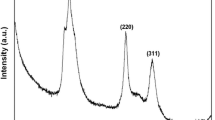Abstract
Transmission electron microscopy and UV–Vis spectroscopy can be used to observe the individual crystallite morphology and the origin of optical activity of quantum dots (QDs). CdSe QDs with different sizes were obtained by controlling their growth time, and the estimated sizes of the CdSe QDs ranged from 2.5 to 5.1 nm. The first excitonic absorption and photoluminescence (PL) peak shifted to lower energy with increasing QD size in the strong confinement regime. The PL spectra included a shoulder peak in the spectra of smaller QDs because of preferential adsorption. A comparison of the empirical trends and experimental results provided a fundamental understanding of the size-dependent properties of the CdSe QDs. In addition, time-resolved PL spectra in conjunction with surface characterization results showed that the PL behavior can be explained by the additional contribution of electron–phonon interaction.




Similar content being viewed by others
References
Chen LY, Chou HL, Chen CH, Tseng CH (2012) Surface modification of CdSe and CdS quantum dots-experimental and density function theory investigation. Nanocryst Synth Charact Appl 8:149–168
Chukwuocha EO, Onyeaju MC, Harry TST (2012) Theoretical studies on the effect of confinement on quantum dots using the Brus equation. World J Condens Matter Phys 2:96–100
de Mello Donegá C, Koole R (2009) Size dependence of the spontaneous emission rate and absorption cross section of CdSe and CdTe quantum dots. J Phys Chem C 113:6511–6520
de Mello Donegá C, Hickey SG, Wuister SF, Vanmaekelbergh D, Meijerink A (2003) Single-step synthesis to control the photoluminescence quantum yield and size dispersion of CdSe nanocrystals. J Phys Chem B 107:489–496
de Mello Donegá C, Bode M, Meijerink A (2006) Size- and temperature-dependence of exciton lifetimes in CdSe quantum dots. Phys Rev B 74:085320
Garrett MD, Dukes AD, McBride JR, Smith NJ, Pennycook SJ, Rosenthal SJ (2008) Band edge recombination in CdSe, CdS and CdSxSe1−x alloy nanocrystals observed by ultrafast fluorescence upconversion: the effect of surface trap states. J Phys Chem C 112:12736–12746
Hu L, Wu H (2016) Influence of size and surface state emission on photoluminescence of CdSe quantum dots under UV irradiation. J Lumin 177:306–313
Jeong S, Lee JS, Nam J, Im K, Hur J, Park JJ, Kim JM, Chon B, Joo T, Kim S (2010) One-step preparation of strongly luminescent and highly loaded CdSe quantum dot-silica films. J Phys Chem C 114:14362–14367
Kalyuzhny G, Murray RW (2005) Ligand effects on optical properties of CdSe nanocrystals. J Phys Chem B 109:7012–7021
Kang I, Wise FW (1997) Electronic structure and optical properties of PbS and PbSe quantum dots. J Opt Soc Am B 14:1632–1646
Kim SH, Man MT, Lee JW, Park K-D, Lee HS (2020a) Influence of size and shape anisotropy on optical properties of CdSe quantum dots. Nanomaterials 10:1589
Kim SH, Man MT, Lee HS (2020b) Size and shell effects on CdSe quantum dots in binary ligand system. Appl Sci Converg Technol 29:87–90
Kuno M, Lee JK, Dabbousi BO, Mikulec FV, Bawendi MG (1997) The band edge luminescence of surface modified CdSe nanocrystallites: probing the luminescing state. J Chem Phys 106:9869–9882
Mashford BS, Stevenson M, Popovic Z, Hamilton C, Zhou Z, Breen C, Steckel J, Bulovic V, Bawendi M, Coe-Sullivan S, Kazlas PT (2013) High-efficiency quantum-dot light-emitting devices with enhanced charge injection. Nat Photon 7:407–412
Mitchell DRG (2008) DiffTools: electron diffraction software tools for DigitalMicrograph™. Microsc Res Tech 71:588–593
Mohamed MB, Tonti D, Al-Salman A, Chemseddine A, Chergui M (2005) Synthesis of high quality zinc blende CdSe nanocrystals. J Phys Chem B 109:10533–10537
Moreels I, Lambert K, De Muynck D, Vanhaecke F, Poelman D, Martins JC, Allan G, Hens Z (2007) Composition and size-dependent extinction coefficient of colloidal PbSe quantum dots. Chem Mater 19:6101–6106
Murray CB, Norris DJ, Bawendi MG (1993) Synthesis and characterization of nearly monodisperse CdE (E = S, Se, Te) semiconductor nanocrystallites. J Am Chem Soc 115:8706–8715
Nozik AJ (2002) Quantum dot solar cells. Physica E 14:115–120
Peng XG, Wickham J, Alivisatos AP (1998) Kinetics of II–VI and III–V colloidal semiconductor nanocrystal growth: “focusing” of size distribution. J Am Chem Soc 120:5343–5344
Philbin JP, Rabani E (2018) Electron–hole correlations govern auger recombination in nanostructures. Nano Lett 18:7889–7895
Qu LH, Peng XG (2002) Control of photoluminescence properties of CdSe nanocrystals in growth. J Am Chem Soc 124:2049–2055
Schlegel G, Bohnenberger J, Potapova I, Mews A (2002) Fluorescence decay time of single semiconductor nanocrystals. Phys Rev Lett 88:137401
Smith AM, Nie SM (2010) Semiconductor nanocrystals: structure, properties, and band gap engineering. Acc Chem Res 43:190–200
Wuister SF, Houselt AV, de Mello DC, Vanmaekelbergh D, Meijerink A (2004) Temperature antiquenching of the luminescence from capped CdSe quantum dots. Angew Chem 116:3091–3095
Zhang J, Crisp RW, Gao J, Kroupa DM, Beard MC, Luther JM (2015) Synthetic conditions for high-accuracy size control of PbS quantum dots. J Phys Chem Lett 6:1830–1833
Funding
This work was supported by the National Research Foundation of Korea (NRF) grant funded by the Korea government (MSIT) (NRF-2021R1A2C1003074), Graduate University of Science and Technology under grant number GUST.STS.ĐT2019-KTVL03, and the “Research Base Construction Fund Support Program” funded by Jeonbuk National University in 2021.
Author information
Authors and Affiliations
Corresponding authors
Ethics declarations
Conflict of interest
On behalf of all authors, the corresponding author states that there is no conflict of interest.
Additional information
Publisher's Note
Springer Nature remains neutral with regard to jurisdictional claims in published maps and institutional affiliations.
Rights and permissions
About this article
Cite this article
Kim, S.H., Shin, T., Man, M.T. et al. Size-dependent energy spacing and surface defects of CdSe quantum dots in strong confinement regime. Appl Nanosci 12, 3297–3302 (2022). https://doi.org/10.1007/s13204-021-02310-8
Received:
Accepted:
Published:
Issue Date:
DOI: https://doi.org/10.1007/s13204-021-02310-8




